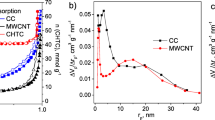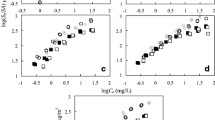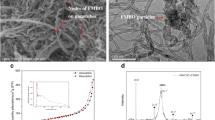Abstract
Single-walled carbon nanotubes, both before (SWNTs) and after treatment (t-SWNTs) with acidified ammonium persulfate, were successfully used to adsorb bisphenol A (BPA) and 17β-estradiol (E2) from aqueous systems. The surface characteristics of the SWNTs and t-SWNTs were analyzed by measuring their surface charge and by imaging their morphological properties through transmission electron microscopy. The extent of defects on the SWNT scaffold generated through acid etching was analyzed by Raman spectroscopy. A total of 19.4, 15.4, and 14.3 mg/g of BPA was adsorbed on SWNTs, while a total of 8.0, 6.4, and 5.1 mg/g was adsorbed on t-SWNTs with a 72-h contact time at 280, 295, and 315 K, respectively. A significantly high fraction of E2 (27.2 mg/g) was absorbed by both SWNTs and t-SWNTs, as compared to BPA. The adsorption kinetics was analyzed using a pseudo-second-order model. Sorption experiments showed that t-SWNTs adsorbed less than half as much BPA as SWNTs, but their E2 adsorption was similar. The sorption mechanism was investigated by performing molecular-level calculations. Adsorption energies calculated using density functional theory show preferential sorption of E2 to SWNTs and graphene (−26.2 kcal/mol on SWNT and −34.1 kcal/mol on graphene) compared to BPA (−17.1 kcal/mol on SWNT and −22.5 kcal/mol on graphene), which were consistent with the experimental findings. Thus, ab initio calculations can mechanistically explain the adsorption differences of BPA and E2 on SWNTs.







Similar content being viewed by others
References
Agnihotri, S., Mota, J. P. B., Rostam-Abadi, M., & Rood, M. J. (2005). Structural characterization of single-walled carbon nanotube bundles by experiment and molecular simulation. Langmuir, 21, 896–904.
Baughman, R. H., Zakhidov, A. A., & de Heer, W. A. (2002). Carbon nanotubes: the route toward applications. Science, 297, 787–792.
Bautista-Toledo, I., Ferro-García, M. A., Rivera-Utrilla, J., Moreno-Castilla, C., & Vegas Fernández, F. J. (2005). Bisphenol A removal from water by activated carbon: effects of carbon characteristics and solution chemistry. Environmental Science & Technology, 39, 6246–6250.
Blanchard, G., Maunaye, M., & Martin, G. (1984). Removal of heavy metals from waters by means of natural zeolites. Water Research, 18, 1501–1507.
Bode, B. M., & Gordon, M. S. (1998). MacMolPlt: a graphical user interface for GAMESS. Journal of Molecular Graphics & Modelling, 16, 133–138.
Burns, J. L., Y-d, Y., Jameson, G. J., & Biggs, S. (1997). A light scattering study of the fractal aggregation behavior of a model colloidal system. Langmuir, 13, 6413–6420.
Chen, S., Shen, W., Wu, G., Chen, D., & Jiang, M. (2005). A new approach to the functionalization of single-walled carbon nanotubes with both alkyl and carboxyl groups. Chemical Physics Letters, 402, 312–317.
Chiang, I. W., Brinson, B. E., Smalley, R. E., Margrave, J. L., & Hauge, R. H. (2001). Purification and characterization of single-wall carbon nanotubes. The Journal of Physical Chemistry. B, 105, 1157–1161.
Costa, S., & Borowiak-Palen, E. (2009). Diameter sensitive effect in singlewalled carbon nanotubes upon acid treatment. Journal of Alloys and Compounds, 486, 386–390.
Coughlin, R. W., & Ezra, F. S. (1968). Role of surface acidity in the adsorption of organic pollutants on the surface of carbon. Environmental Science & Technology, 2, 291–297.
Day, P. N., Pachter, R., Gordon, M. S., & Merrill, G. N. (2000). A study of water clusters using the effective fragment potential and Monte Carlo simulated annealing. The Journal of Chemical Physics, 112, 2063–2073.
Dresselhaus, M. S., Dresselhaus, G., Jorio, A., Souza Filho, A. G., & Saito, R. (2002). Raman spectroscopy on isolated single wall carbon nanotubes. Carbon, 40, 2043–2061.
Fan, Z., Casey, F. X. M., Hakk, H., & Larsen, G. L. (2007). Persistence and fate of 17β-estradiol and testosterone in agricultural soils. Chemosphere, 67, 886–895.
Feng, Y., Zhang, Z., Gao, P., Su, H., Yu, Y., & Ren, N. (2010). Adsorption behavior of EE2 (17α-ethinylestradiol) onto the inactivated sewage sludge: Kinetics, thermodynamics and influence factors. Journal of Hazardous Materials, 175, 970–976.
Ferguson, P. L., Chandler, G. T., Templeton, R. C., DeMarco, A., Scrivens, W. A., & Englehart, B. A. (2008). Influence of sediment-amendment with single-walled carbon nanotubes and diesel soot on bioaccumulation of hydrophobic organic contaminants by benthic invertebrates. Environmental Science & Technology, 42, 3879–3885.
Forrest, S. R., & Witten, T. A., Jr. (1979). Long-range correlations in smoke-particle aggregates. Journal of Physics A: Mathematical and General, 12, L109.
Furtado, C. A., Kim, U. J., Gutierrez, H. R., Pan, L., Dickey, E. C., & Eklund, P. C. (2004). Debundling and dissolution of single-walled carbon nanotubes in amide solvents. Journal of the American Chemical Society, 126, 6095–6105.
Gonzo, E., & Gonzo, L. (2005). Kinetics of phenol removal from aqueous solution by adsorption onto peanut shell acid-activated carbon. Adsorption Science and Technology, 23, 289–302.
Goodson, A., Robin, H., Summerfield, W., & Cooper, I. (2004). Migration of bisphenol A from can coatings—effects of damage, storage conditions and heating. Food Additives and Contaminants, 21, 1015–1026.
Gordon, M.S., Schmidt, M.W., Dykstra, C.E., Frenking, G., Kim, K.S., Scuseria, G.E. (2005). Advances in electronic structure theory: GAMESS a decade later. Theory and applications of computational chemistry: the first forty years. Elsevier, p 1167–1189.
Gordon, M.S., Slipchenko, L., Li, H., Jensen, J.H., Spellmeyer, D.C., Wheeler, R. (2007). The effective fragment potential: a general method for predicting intermolecular interactions. Annual reports in computational chemistry. Elsevier, p 177–193.
Gotovac, S., Yang, C. M., Hattori, Y., Takahashi, K., Kanoh, H., & Kaneko, K. (2007). Adsorption of polyaromatic hydrocarbons on single wall carbon nanotubes of different functionalities and diameters. Journal of Colloid and Interface Science, 314, 18–24.
Grimme, S., Antony, J., Ehrlich, S., & Krieg, H. (2010). A consistent and accurate ab initio parametrization of density functional dispersion correction (DFT-D) for the 94 elements H-Pu. Journal of Chemical Physics, 132, 154104.
Grimme, S., Ehrlich, S., & Goerigk, L. (2011). Effect of the damping function in dispersion corrected density functional theory. Journal of Computational Chemistry, 32, 1456–1465.
Gruneis, A., Saito, R., Kimura, T., Cançado, L. G., Pimenta, M. A., Jorio, A., Souza, A. G., Dresselhaus, G., & Dresselhaus, M. S. (2002). Determination of two-dimensional phonon dispersion relation of graphite by Raman spectroscopy. Physical Review B, 65, 155405.
Hersam, M. C. (2008). Progress towards monodisperse single-walled carbon nanotubes. National Nanotechnology, 3, 387–394.
Ho, Y. S., Ng, J. C. Y., & McKay, G. (2000). Kinetics of pollution sorption by biosorbents. Review in Separation and Purification Methods, 29, 189–232.
Hu, H., Zhao, B., Itkis, M. E., & Haddon, R. C. (2003). Nitric acid purification of single-walled carbon nanotubes. The Journal of Physical Chemistry. B, 107, 13838–13842.
Hu, H., Yu, A., Kim, E., Zhao, B., Itkis, M. E., Bekyarova, E., & Haddon, R. C. (2005). Influence of the zeta potential on the dispersability and purification of single-walled carbon nanotubes. The Journal of Physical Chemistry. B, 109, 11520–11524.
Hu, J., Chen, C. L., Zhu, X. X., & Wang, X. K. (2009). Removal of chromium from aqueous solution by using oxidized multiwalled carbon nanotubes. Journal of Hazardous Materials, 162, 1542–1550.
Huang, Q., & Weber, W. J. (2005). Transformation and removal of bisphenol A from aqueous phase via peroxidase-mediated oxidative coupling reactions: efficacy, products, and pathways. Environmental Science & Technology, 39, 6029–6036.
Humphrey, W., Dalke, A., & Schulten, K. (1996). VMD: visual molecular dynamics. Journal of Molecular Graphics, 14, 33–38.
Jorio, A., Saito, R., Hafner, J. H., Lieber, C. M., Hunter, M., McClure, T., Dresselhaus, G., & Dresselhaus, M. S. (2001). Structural (n, m) determination of isolated single-wall carbon nanotubes by resonant Raman Scattering. Physical Review Letters, 86, 1118.
Joseph, L., Zaib, Q., Khan, I. A., Berge, N. D., Park, Y. G., Saleh, N. B., & Yoon, Y. (2011). Removal of bisphenol A and 17a-ethinyl estradiol from landfill leachate using single-walled carbon nanotubes. Water Research, 45, 4056–4068.
Kastner, J., Carr, J. M., Keal, T. W., Thiel, W., Wander, A., & Sherwood, P. (2009). DL-FIND: an open-source geometry optimizer for atomistic simulations. Journal of Physical Chemistry A, 113, 11856–11865.
Kolpin, D. W., Furlong, E. T., Meyer, M. T., Thurman, E. M., Zaugg, S. D., Barber, L. B., & Buxton, H. T. (2002). Pharmaceuticals, hormones, and other organic wastewater contaminants in U.S. streams, 1999–2000: a national reconnaissance. Environmental Science & Technology, 36, 1202–1211.
Kukovecz, A., Pichler, T., Pfeiffer, R., Kramberger, C., & Kuzmany, H. (2003). Diameter selective doping of single wall carbon nanotubes. Physical Chemistry Chemical Physics, 5, 582–587.
Kuo, C. Y. (2009). Comparison with as-grown and microwave modified carbon nanotubes to removal aqueous bisphenol A. Desalination, 249, 976–982.
Laganà, A., Bacaloni, A., De Leva, I., Faberi, A., Fago, G., & Marino, A. (2004). Analytical methodologies for determining the occurrence of endocrine disrupting chemicals in sewage treatment plants and natural waters. Analytica Chimica Acta, 501, 79–88.
Li, Y.-H., Wang, S., Wei, J., Zhang, X., Xu, C., Luan, Z., Wu, D., & Wei, B. (2002). Lead adsorption on carbon nanotubes. Chemical Physics Letters, 357, 263–266.
Li, Y.-H., Wang, S., Zhang, X., Wei, J., Xu, C., Luan, Z., & Wu, D. (2003). Adsorption of fluoride from water by aligned carbon nanotubes. Materials Research Bulletin, 38, 469–476.
Liu, G., Ma, J., Li, X., & Qin, Q. (2009). Adsorption of bisphenol A from aqueous solution onto activated carbons with different modification treatments. Journal of Hazardous Materials, 164, 1275–1280.
Lu, C. S., Chung, Y. L., & Chang, K. F. (2005). Adsorption of trihalomethanes from water with carbon nanotubes. Water Research, 39, 1183–1189.
Ma, J., Wang, J. N., & Wang, X. X. (2009). Large-diameter and water-dispersible single-walled carbon nanotubes: synthesis, characterization and applications. Journal of Materials Chemistry, 19, 3033–3041.
Mauter, M. S., & Elimelech, M. (2008). Environmental applications of carbon-based nanomaterials. Environmental Science & Technology, 42, 5843–5859.
Moreno-Castilla, C., Carrasco-Marín, F., & Mueden, A. (1997). The creation of acid carbon surfaces by treatment with (NH4)2S2O8. Carbon, 35, 1619–1626.
Niyogi, S., Hamon, M. A., Hu, H., Zhao, B., Bhowmik, P., Sen, R., Itkis, M. E., & Haddon, R. C. (2002). Chemistry of single-walled carbon nanotubes. Accounts of Chemical Research, 35, 1105–1113.
Pan, B., & Xing, B. (2010). Competitive and complementary adsorption of bisphenol A and 17α-ethinyl estradiol on carbon nanomaterials. Journal of Agricultural and Food Chemistry, 58, 8338–8343.
Pan, B., Lin, D., Mashayekhi, H., & Xing, B. (2008). Adsorption and hysteresis of bisphenol A and 17α-ethinyl estradiol on carbon nanomaterials. Environmental Science & Technology, 42, 5480–5485.
Pan, B., Sun, K., & Xing, B. (2010). Adsorption kinetics of 17α-ethinyl estradiol and bisphenol A on carbon nanomaterials. II. Concentration-dependence. Journal of Soils and Sediments, 10, 845–854.
Plata, D. L., Gschwend, P. M., & Reddy, C. M. (2008). Industrially synthesized single-walled carbon nanotubes: compositional data for users, environmental risk assessments, and source apportionment. Nanotechnology, 19, 185706.
Pyrzynska, K., Stafiej, A., & Biesaga, M. (2007). Sorption behavior of acidic herbicides on carbon nanotubes. Mikrochimica Acta, 159, 293–298.
Saleh, N. B., Pfefferle, L. D., & Elimelech, M. (2008). Aggregation kinetics of multiwalled carbon nanotubes in aquatic systems: Measurements and environmental implications. Environmental Science & Technology, 42, 7963–7969.
Saleh, N. B., Pfefferle, L. D., & Elimelech, M. (2010). Influence of biomacromolecules and humic acid on the aggregation kinetics of single-walled carbon nanotubes. Environmental Science & Technology, 44, 2412–2418.
Schmidt, M. W., Baldridge, K. K., Boatz, J. A., Elbert, S. T., Gordon, M. S., Jensen, J. H., Koseki, S., Matsunaga, N., Nguyen, K. A., & Su, S. (1993). General atomic and molecular electronic structure system. Journal of Computational Chemistry, 14, 1347–1363.
Smith, T., Slipchenko, L. V., & Gordon, M. S. (2008). Modeling pi–pi interactions with the effective fragment potential method: the benzene dimer and substituents. Journal of Physical Chemistry A, 112, 5286–5294.
Snyder, S. A., Westerhoff, P., Yoon, Y., & Sedlak, D. L. (2003). Pharmaceuticals, personal care products, and endocrine disruptors in water: implications for the water industry. Environmental Engineering Science, 20, 449–469.
Souza Filho, A. G., Jorio, A., Samsonidze, G. G., Dresselhaus, G., Pimenta, M. A., Dresselhaus, M. S., Swan, A. K., & Uuml, S. M. (2003). Competing spring constant versus double resonance effects on the properties of dispersive modes in isolated single-wall carbon nanotubes. Physical Review B, 67, 035427.
Stepanian, S. G., Karachevtsev, M. V., Glamazda, V. A., & Adamowicz, L. (2009). Raman spectroscopy study and first-principles calculations of the interaction between nucleic acid bases and carbon nanotubes. Journal of Physical Chemistry A, 113, 3621–3629.
Su, F. S., & Lu, C. S. (2007). Adsorption kinetics, thermodynamics and desorption of natural dissolved organic matter by multiwalled carbon nanotubes. Journal of Environmental Science and Health, 42, 1543–1552.
Tournus, F., & Charlier, J. C. (2005). Ab initio study of benzene adsorption on carbon nanotubes. Physical Review B, 71, 165421.
Ufimtsev, I. S., & Martinez, T. J. (2009). Quantum chemistry on graphical processing units. 3. Analytical energy gradients, geometry optimization, and first principles molecular dynamics. Journal of Chemical Theory and Computation, 5, 2619–2628.
Upadhyayula, V. K. K., Deng, S. G., Smith, G. B., & Mitchell, M. C. (2009). Adsorption of Bacillus subtilis on single-walled carbon nanotube aggregates, activated carbon and NanoCeram (TM). Water Research, 43, 148–156.
Wang, F., Yao, J., Sun, K., & Xing, B. (2010). Adsorption of dialkyl phthalate esters on carbon nanotubes. Environmental Science & Technology, 44, 6985–6991.
Yang, K., & Xing, B. (2007). Desorption of polycyclic aromatic hydrocarbons from carbon nanomaterials in water. Environmental Pollution, 145, 529–537.
Yang, K., Zhu, L., & Xing, B. (2006). Adsorption of polycyclic aromatic hydrocarbons by carbon nanomaterials. Environmental Science & Technology, 40, 1855–1861.
Yoon, Y. M., Westerhoff, P., Snyder, S. A., & Esparza, M. (2003). HPLC-fluorescence detection and adsorption of bisphenol A, 17 beta-estradiol, and 17 alpha-ethynyl estradiol on powdered activated carbon. Water Research, 37, 3530–3537.
Yoon, Y., Ryu, J., Oh, J., Choi, B.-G., & Snyder, S. A. (2010). Occurrence of endocrine disrupting compounds, pharmaceuticals, and personal care products in the Han River (Seoul, South Korea). Science of the Total Environment, 408, 636–643.
Yu, A., Su, C.-C. L., Roes, I., Fan, B., & Haddon, R. C. (2009). Gram-scale preparation of surfactant-free, carboxylic acid groups functionalized, individual single-walled carbon nanotubes in aqueous solution. Langmuir, 26, 1221–1225.
Zhang, J., Zou, H., Qing, Q., Yang, Y., Li, Q., Liu, Z., Guo, X., & Du, Z. (2003). Effect of chemical oxidation on the structure of single-walled carbon nanotubes. The Journal of Physical Chemistry. B, 107, 3712–3718.
Acknowledgments
This research was supported by GS E&C and the Korea Ministry of Environment, “Project, 414-111-004.” The authors also acknowledge the University of South Carolina’s High Performance Computing Group for the computing time used in this research.
Author information
Authors and Affiliations
Corresponding author
Electronic Supplementary Material
Below is the link to the electronic supplementary material.
Fig. S1
(a) Schematic of diagram of the dialysis system for functionalization of SWNTs and (b) rapid loss of excess acidified water from inside the dialysis membrane resulting in stable suspension of functionalized SWNTs and deposition of unwanted impurities. (DOC 162 kb)
Rights and permissions
About this article
Cite this article
Zaib, Q., Khan, I.A., Saleh, N.B. et al. Removal of Bisphenol A and 17β-Estradiol by Single-Walled Carbon Nanotubes in Aqueous Solution: Adsorption and Molecular Modeling. Water Air Soil Pollut 223, 3281–3293 (2012). https://doi.org/10.1007/s11270-012-1109-5
Received:
Accepted:
Published:
Issue Date:
DOI: https://doi.org/10.1007/s11270-012-1109-5




